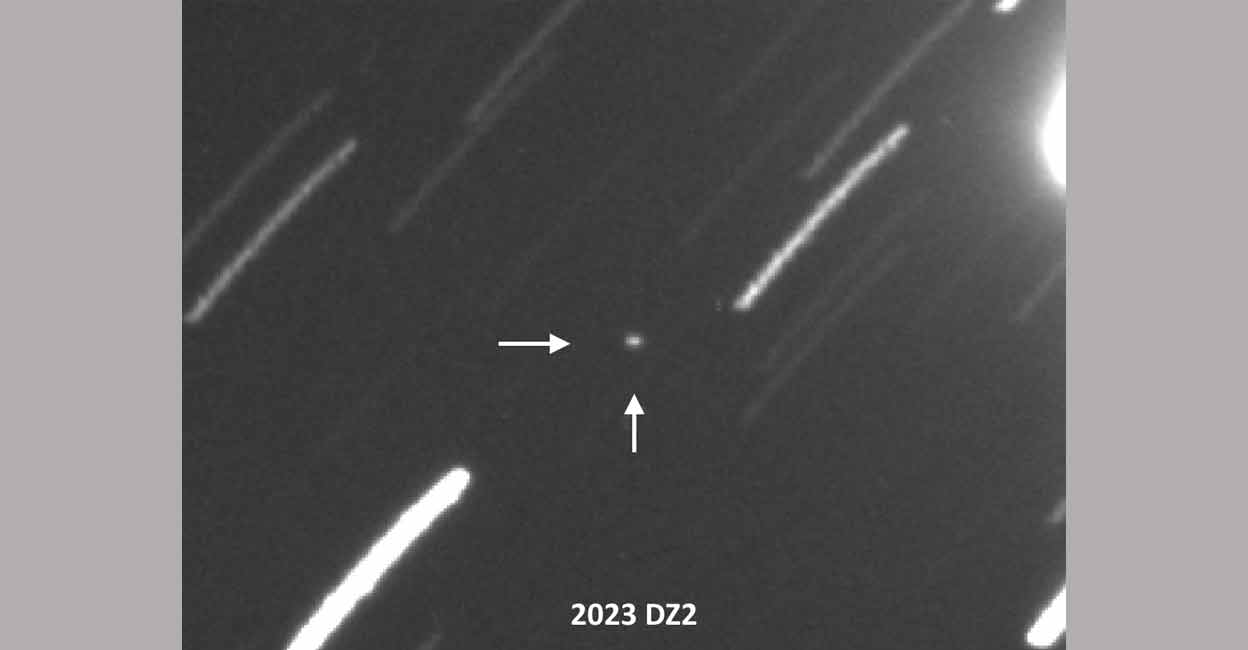Asteroid 200 times more powerful than 'Fat Man' will come dangerously close to Earth on Sunday

Mail This Article
Asteroid 2023 DZ2 is zipping past our Earth this weekend at less than half a lunar distance (i.e. half the distance between the Earth and our moon).
Astronomically speaking, this is a close shave, luckily without a burning razor nick this time!
An object of this size (about 100 metres) passing so close to Earth (about 110,000 miles away) is a rather infrequent event (once in a few decades). This asteroid will come closest to Earth this Sunday, 1:21 am (Indian Standard Time) on 26 March 2023 and whizz past at a speed of about 28,000 km/h.
Because an object of a substantial size is coming so close to Earth, it would be visible with a decent set of binoculars and small telescopes.
Amateur astronomers are encouraged to chase it by burning a bit of midnight oil. It will be visible near the constellation of Cancer in our night sky.
EUROpean Near Earth Asteroids Research (EURONEAR) project astronomers discovered this asteroid 2023 DZ2 in late February this year using the powerful Isaac Newton telescope at La Palma Observatory in the Spanish Canary Islands. Since then orbit experts have been computing its trajectory to assess the risk probabilities of a possible collision with Earth.
Fortunately, this asteroid will safely miss our Earth in 2023. This asteroid will come close to Earth again in March 2026.

This shows the growing importance of continuously tracking these types of objects in the sky and constantly computing the collision possibilities. An object as small (about 100 metres) as 2023 DZ2 could easily wipe out a big city in case it really collided with Earth. The estimated impact energy would be close to that of 200 times the atomic bomb ‘Fat Man’ dropped at Nagasaki, Japan during the second world war.
A collision of an object of much smaller size (about 50 metres) with our Earth was the reason for the Tunguska impact event which happened in Russia in 1908.
The space rock managed to fire up and flatten a whole forest in Siberia at that time. Luckily it was an uninhabited area and hence there were no human casualties. If it was an inhabited area, god forbid, the whole town/city would have been wiped out.
"Two interesting Near-Earth Asteroids, 2023 DW and 2023 DZ2, have been discovered recently, both capable of causing Tunguska-class events if they fall on our planet. The worldwide network of discovery telescopes has been able to detect them, and the impact monitoring software robots in Europe and the USA have quickly been able to exclude possibilities of collision with the Earth in the next century, thanks to the immediate follow-up observations that have been made," explains Dr Giovanni Valsecchi, orbital dynamics expert at INAF, Rome, Italy and the past President of Planetary Systems and Astrobiology Division of the International Astronomical Union (IAU).
This is one of the areas where AI could have a significant impact on astronomy. Algorithms to identify, chase and track potentially hazardous asteroids continuously by doing follow-up observations and feeding those live observational data to numerical integration software to interpolate and extrapolate trajectories to compute impact risks are gaining momentum in recent times.
"Risks of this kind have always existed, but we have not had the ability to know about them until very recently. This is a testimony to the ingenuity and hard work of instrument designers and scientists. This is not something that should cause anxiety," says Dr Matthew Tiscareno, planetary scientist at Search for Extra-Terrestrial Intelligence (SETI) Institute, USA and the Vice-Chair of the Division of Dynamical Astronomy, American Astronomical Society.
This is reassuring news for humans in general. Some solar system objects might pose an immediate threat during their first instant of discovery. But once we get better clarity on their orbits with further follow-up observations, the threat level slowly diminishes in due course.
During the initial observation arc, asteroid 2023 DZ2 had a 1-in-430 chance to impact Earth in March 2026. But the latest observations and better accuracy of the orbit have safely ruled out a direct collision.
This is exactly what happened to another asteroid namely 2023 DW which was also discovered in February this year.
"Why is this object of such interest to astronomers? Not because it will collide with our planet; it won’t — at least not in the near future. But its size, similar to that of the famous “Tunguska object” that hit the Earth on 30th June 1908, puts it amongst the largest of the most recently found Earth-approaching asteroids," explains international comet expert, Prof Mark Bailey MBE, a former Vice President of the Royal Astronomical Society, UK.
"It also has an unusually short period of revolution around the Sun, less than a year, so it has frequent chances to come close to Earth. This raises the stakes for a possible collision, but also raises questions as to where such unusual asteroids come from and how many are there in the solar system remaining to be found?," adds Prof Bailey, who works on the origins of small solar system bodies.
All these data point towards the fact there is a real-life risk dangling over our planet and we need to be wary of such potentially hazardous bodies coming in future from outer space. In any case, there is nothing to panic about both these recently discovered asteroids at the moment. But that doesn’t automatically mean that all the celestial objects in future are going to be equally safe either.
All we need to do is keep calm and keep observing and keep studying them.
(The author is a professional meteor scientist at Institute of Celestial Mechanics, Paris Observatory, France, and a jury committee member of the Dannie Heineman Prize of American Astronomical Society and American Institute of Physics)

